This article needs additional citations for verification .(January 2024) |


Pietro Bardellino (17 February 1728, Naples - 1806, Naples) was an Italian painter in the Rococo style.
This article needs additional citations for verification .(January 2024) |


Pietro Bardellino (17 February 1728, Naples - 1806, Naples) was an Italian painter in the Rococo style.
His personal style derives from that of his teacher, Francesco De Mura. As early as 1750, he was commissioned to paint the ceiling in the large room of the Ospedale degli Incurabili, depicting Machaon curing Menelaus.
He created other notable, decorative works at the Oratorio della Confraternita dei Bianchi dello Spirito Santo (1753), the Cattedrale di Bitonto (1764), and the basilica of San Giacomo degli Spagnoli (1778); all of a religious nature. He also decorated the homes of several noble families. [1]
In 1773, he was appointed a member of the Accademia Napoletana del Disegno (now the Accademia di Belle Arti di Napoli), to succeed the recently deceased Luigi Vanvitelli. In 1779, he was named a master of the Accademia. In 1789, the protested the change in emphasis from Rococo to Neoclassical styles, in a letter to the King, and his influence there waned. [1]
His largest, most challenging project came in 1781: the ceiling of the Grand Hall at the Palazzo degli Studi , which later became part of the Real Museo Borbonico. It depicts the apotheosis of King Ferdinand IV and Queen Maria Carolina.
During his later years, his notable works include a portrait of the architect Gaetano Barba (1790), and the frescoes for the Biblioteca dei Girolamini (1792). Several of his works at the Basilica di Santa Chiara have been lost.
In 1803, he and Desiderio De Angelis (1743-1811) were chosen to operate the nude drawing school at the Accademia, but his appointment was not confirmed until the year he died. [1]

Giovanni Battista Tiepolo, also known as GiambattistaTiepolo, was an Italian painter and printmaker from the Republic of Venice who painted in the Rococo style, considered an important member of the 18th-century Venetian school. He was prolific, and worked not only in Italy, but also in Germany and Spain.

Luca Giordano was an Italian late-Baroque painter and printmaker in etching. Fluent and decorative, he worked successfully in Naples, Rome, Florence, and Venice, before spending a decade in Spain.

Guido Reni was an Italian painter of the Baroque period, although his works showed a classical manner, similar to Simon Vouet, Nicolas Poussin, and Philippe de Champaigne. He painted primarily religious works, but also mythological and allegorical subjects. Active in Rome, Naples, and his native Bologna, he became the dominant figure in the Bolognese School that emerged under the influence of the Carracci.

Sebastiano Conca was an Italian painter.

Belisario Corenzio was a Greek-Italian painter, active in Venice and Naples. He is one of few Greek painters that did not belong to the Cretan Renaissance like his contemporaries of the time. He escaped the maniera greca completely. He adopted the Venetian style. Other similar Greek painters were Marco Basaiti, Ioannis Permeniates, Antonio Vassilacchi and El Greco. He was sometimes referred to as Il Greco. His teacher was prominent Venetian painter Tintoretto. In 1590, at age 32 Corenzio settled in Naples. Corenzio was influenced by Cavalier d'Arpino. He continued to flourish in the region. His apprentices included: Luigi Rodriguez, Andrea di Leone, Onofrio De Lione and Massimo Stanzione. Corenzio painted many frescos that survived today. Some of his works are in the Church of San Severino and Certosa di San Martino. His style resembles Caravaggio. An Italian legend in Naples exists involving Corenzio, Spanish painter Jusepe de Ribera, and Battistello Caracciolo. They were referred to as the Cabal of Naples. The three painters were rumored to have poisoned their competition for painting contracts. The rumors lack documented evidence. The three painters were very popular in Naples. Corenzio frescoed the Crypt that holds the remains of Matthew the Apostle at Salerno Cathedral and it depicts scenes from the Gospel of Matthew. Corenzio was one of the most celebrated fresco painters in Naples during his time. His drawings can be found all over the world namely at the Metropolitan Museum, Museo di Capodimonte and Louvre. More recently, his life and work was studied by the Greek art historian Panayotis K. Ioannou in a comprehensive monograph.

Ca' Rezzonico is a palazzo and art museum on the Grand Canal in the Dorsoduro sestiere of Venice, Italy. It is a particularly notable example of the 18th century Venetian baroque and rococo architecture and interior decoration, and displays paintings by the leading Venetian painters of the period, including Francesco Guardi and Giambattista Tiepolo. It is a public museum dedicated to 18th-century Venice and one of the 11 venues managed by the Fondazione Musei Civici di Venezia.
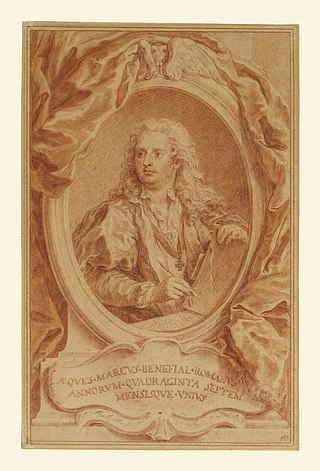
Marco Benefial was an Italian, proto-Neoclassical painter, mainly active in Rome. Benefial is best known for his repudiation of 18th century decorative Rococo styles pre-eminent in the Rome dominated by Carlo Maratta pupils. His paintings portrayed tangible human figures, with complex treatment of space, and luminous, warm colors. Along with the altarpieces and frescoes, he also painted many portraits. Because he partnered with some inferior artists who subsequently received credit, some of his paintings have been frequently misidentified.

Pietro della Vecchia, Pietro della Vècchia or Pietro Vècchia, formerly incorrectly called Pietro Muttoni was a versatile Italian painter who worked in many genres and created altarpieces, portraits, genre scenes and grotesques. He also created pastiches of the work of leading Italian painters of the 16th century. He designed cartoons for mosaics and worked as an art restorer. Della Vecchia was also sought after as an art expert and did expert valuations of artworks. He worked most of his life in Venice and its environs except for a brief stay in Rome.

Guglielmo Borremans or Guglielmo Fiamingo (1670–1744) was a Flemish painter whose documented career took principally place in Italy, in particular Naples, Cosenza and Sicily. Here he was one of the pre-eminent late-Baroque fresco painters of the first half of the 17th century who received multiple commissions to decorate churches and palaces.

Giacinto Brandi was an Italian painter from the Baroque era, active mainly in Rome and Naples.
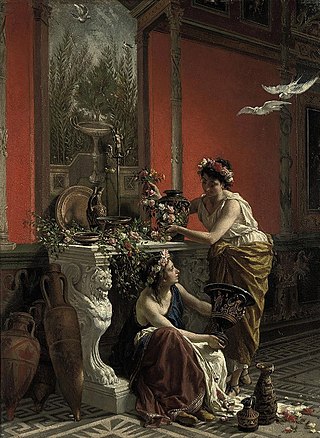
Cesare Mariani was an Italian painter and architect of the late-19th century, active in Rome and Ascoli Piceno.

Giovanni Battista Sassi was an Italian painter, active mainly in Milan and other areas of Lombardy, who painted in a late-Baroque and Rococo style.

Benedetto Innocenzo Alfieri was an Italian architect, a representative of the late-Baroque or Rococo style.
Antonio Canevari was an Italian architect of the Rococo and Neoclassical periods.

The Ospedale degli Incurabili or Complesso degli Incurabili is an ancient and prominent hospital complex located on Via Maria Longo in central Naples, Italy. Part of the complex, including the remarkable pharmacy, are now the Museo delle arti sanitarie of Naples.
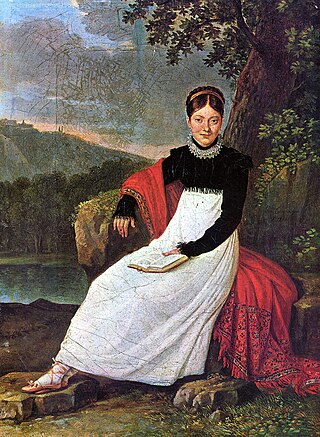
Giuseppe Cammarano was an Italian painter of frescoes and portraits.

Giacinto Diano or Diana was an Italian painter, active in Southern Italy in a style that mixes Rococo and Neoclassicism.
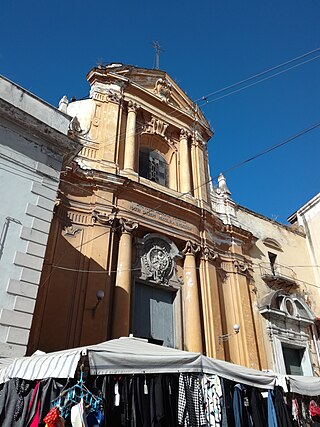
Giuseppe Astarita was an Italian architect and engineer of the late-Baroque or Rococo period. He was a pupil of Domenico Antonio Vaccaro and collaborated with Ferdinando Sanfelice; his style is influenced by Guarino Guarini. He worked on the following buildings, sometimes in work of reconstruction.

Fedele Gioffredo Fischetti was an Italian painter of the Neoclassical period. Most of his works are frescoes of an allegorical or mythological nature.
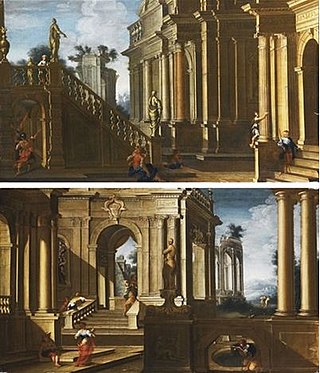
Pietro Francesco Garoli, also seen as Garola, Garolo and Carolli or Pier Francesco was an Italian painter and architect; known primarily for vedute and capricci. Some documents give his place of birth as Giaveno, although that may be where his family was from. The first biographical information about Garoli comes from 1730, fourteen years after his death, and the sources disagree on several details.
{